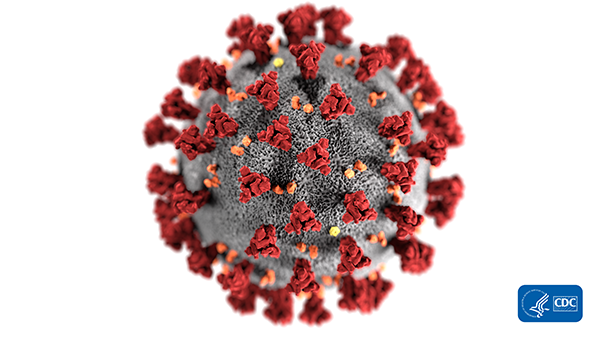Why “Coronavirus” is Different than Equine Coronavirus

CDC image of COVID-19: Alissa Eckert, MS Dan Higgins, MAM
By: Brittany Bevis
Media networks both at home and abroad have been abuzz with news of the current coronavirus outbreak. The respiratory illness that originated in Wuhan, China has led to 70,635 confirmed cases in China, a death toll reaching 1,772, and 694 cases in 25 other countries, (NBC, 2020).
Also in the news recently is the report of a case of equine coronavirus in Arizona. Understandably, it might seem as if the two are related. However, this isn’t the case. Equine coronavirus, or ECoV, is NOT the same strain of respiratory illness in humans that has since been deemed by the World Health Organization as COVID-19.
They certainly sound similar, and that’s because a coronavirus is a microscopic strand of RNA, which is genetic material similar to DNA, wrapped in protein. When examined under a microscope, they look like they’re wearing tiny crowns, hence the name. Because this is a virus and not a bacteria, it cannot multiply on its own and must invade a host cell in order to sustain resources to make more viruses. Severe acute respiratory syndrome, SARS-CoV, is also a coronavirus, as is BCoV, a respiratory disease in cattle, (theHorse, 2020).
Differences
COVID-19 (humans)
- Diagnosis is done by either a blood sample or respiratory tract sample taken from the nose or throat.
- Symptoms include coughing, shortness of breath, and fever that can result in anywhere from mild symptoms to death.
- Transmission takes place through the air or by touching infected surfaces.
ECoV (horses)
- Diagnosis is done by a fecal sample.
- Symptoms include fever, lack of appetite, depression, colic, and diarrhea.
- Transmission occurs through contact with feces.
Similarities
- Both are viral diseases that are highly contagious.
- There is no known vaccine for either disease.
- Primary care is supportive in nature and based upon treating the symptoms.
- Isolation and quarantine of confirmed cases is recommended to prevent spread.
For more information about how to protect your horse from equine coronavirus, visit this fact sheet from the Equine Disease Communication Center.
The Facts
As far as COVID-19 is concerned, it’s definitely a much bigger problem to the general population than ECoV. The number of international locations with positive cases (which now includes the U.S. as of Jan. 30th) include Canada, France, Germany, Russia, Spain, Sweden, the United Kingdom, just to name a few. Meanwhile, in the U.S., states with confirmed cases include Arizona, California, Illinois, Massachusetts, Texas, Washington, and Wisconsin.
The Centers for Disease Control and Prevention has created a webpage dedicated to COVID-19, which will be updated on Mondays, Wednesdays, and Fridays. The most recent update indicated that the current PUI (people under investigation) in the US is at 15 and there are 60 pending. However, those totals do not include Americans recently evacuated from the Diamond Princess cruise ship.
According to NBC News, more than 300 U.S. citizens who had been passengers on a Diamond Princess cruise ship were recently evacuated and sent back to the U.S. on flights that landed at Travis Air Force Base in California and Lackland Air Force Base in Texas on Monday, February 17th. As a result, they will now be subjected to a 14-day quarantine.
The ship was originally placed under quarantine February 4th, so the Americans and other passengers have faced nearly two weeks of an extended stay on the ship. Fourteen Americans were among hundreds evacuated from the ship who have since tested positive for the virus.
Horse Related News
Last week, the decision was made to cancel Asia Horse Week, an event scheduled to take place February 13-16 at the AsiaWorld Expo in Hong Kong. Now, in its third year, the event was billed as an educational conference, exhibition, and competition combination.
A notice that appeared on the event’s website read as follows: “In light of the recent developments of the 2019-nCoV Coronavirus epidemic, which is currently affecting China and other countries, and under the strong advice of local authorities of the Hong Kong SAR, we have made the decision that the Asia Horse Week 2020 will not take place. It was not an easy decision, but it is necessary in order to guarantee our guests their health and safety, which is our utmost priority.”
The Spread
According to the CDC, the virus is thought to be spread from person to person, as well as by droplets that enter the air when an infected person coughs or sneezes. In addition, it is possible that a person can contract COVID-19 by touching a surface that has the virus on it and then touching his or her eyes, nose, or mouth. The virus is thought to be the most contagious when people show the most symptoms; however, there have been reports of virus spread being possible before symptoms begin to show.
While we might see pictures in the news of people wearing face masks, the CDC actually doesn’t recommend for people, who aren’t sick, to wear a facemark for prevention. However, they should be used by people who are already sick in order to help prevent the disease from spreading.
Unfortunately, there is no specific anti-viral treatment recommended for COVID-19. Instead, supportive care is based upon controlling and relieving symptoms.

CDC activated its Emergency Operations Center to assist public health partners in responding to the coronavirus disease 2019 outbreak first identified in Wuhan, China. Credit- James Gathany
Risk to the American Public
Although there is a number of confirmed cases in seven U.S. states, the CDC believes that the risk to the American public, at this time, is low. However, we horse people frequently travel a lot for events across the country, so what can you do to help protect yourself?
Recommendations to help prevent the spread of COVID-19 are similar to those we use during cold and flu season. Avoid contact with people who are sick and avoid touching your mouth, eyes, and nose. Clean and disinfect all surfaces. Wash your hands for at least 20 seconds or use a 60% alcohol based disinfectant.
Because it’s also flu season, the CDC recommends getting a flu vaccine and taking preventative actions to stop the spread of germs. If you have been to China, or been exposed to someone who is sick with COVID-19 during the last 14 days, seek immediate medical advice. Avoid travel, stay home, and separate yourself from others. Wear a face mask and cover your nose and mouth when sneezing. Wash your hands frequently or use a 60% alcohol-based sanitizer.
Interspecies Spreading
It is thought that COVID-19 originated from an animal source. Bloomberg News cites the US Centers for Disease Control and Prevention estimating that three out of four emerging infectious diseases comes from an animal source, (Bloomberg, 2020). The article also quotes a researcher from the Duke-National University of Singapore Medical School as having 90% confidence that the new disease is from a bat-borne virus.
It has also been reported that COVID-19 originated from a “wet market” in Wuhan, China. These open air markets sell all different kinds of processed and live, wild animal products like seafood, poultry, camel, donkey, snakes, rats, ect, (Yahoo UK, 2010).
Constantly evolving viruses mutate easily. When a virus makes the jump from animal to human, it’s considered to be a zoonotic disease. Remember the deadly Sars and Mers? They are both coronavirus strains that made the jump from animals to humans. Both are thought to have originated in bats. The masked palm civet was the intermediate host for Sars between bats and humans, and the camel was the intermediate host for Mers, (Yahoo, UK, 2020).
Given that train of thought, should you be concerned about your horses or other animals with the new COVID-19? Likely not, according to the CDC. While the virus may have originated from an animal source, it’s since mutated and is spreading from person to person. However, if you are sick with COVID-19, it’s a good idea to avoid contact with pets or other animals. Although there currently haven’t been any reports of animals becoming sick with COVID-19, there are certain types of coronavirus that can cause illness in animals.
While the current threat level from COVID-19 to the American public is low, it certainly doesn’t hurt to be informed and prepared. As this global viral outbreak evolves, the CDC will continue to update the situation as needed.
Additional Resources
Click here to view a global map of confirmed cases of COVID-19.
Click here to learn more about COVID-19 from the CDC.










